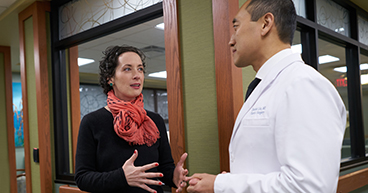
Part of my job as a reconstructive plastic surgeon involves educating women about breast reconstruction. I strongly believe that all women who have been diagnosed with breast cancer should know their options. Many women are unaware of the wide range of breast reconstruction options available, and even fewer understand that the timing of their decision to undergo reconstruction may greatly impact their options and results.
Although several techniques exist, many women choose implant-based reconstruction. Virtually everyone has heard of breast implants, but it’s important to recognize the differences between cosmetic breast augmentation and post-mastectomy breast reconstruction. Specifically, consistently positive aesthetic results are easier to achieve with breast augmentation. Single-stage implant breast reconstruction may be possible in some women, but many women require a temporary tissue expander, using an adjustable implant filled with saline.
The following characteristics help surgeons choose the best implant for your individual needs:
Fill: Saline implants can be filled with varying amounts of sterile saltwater. If the shell leaks, the implant collapses and releases saline into the body. Generally speaking, these implants have more visible rippling under thin skin. Silicone gel feels more like natural breast tissue, but implant ruptures may be more difficult to detect and require ultrasound/MRI screening. Today’s fourth- and fifth-generation implants containing “highly cohesive silicone gel” are slightly firmer and commonly known as “gummy bear implants.”
Shape: Round implants have a circular base and varying degrees of projection (how much they stick out from the chest), providing more fullness to the upper breast. Some older-generation, round implants are under-filled and may show more rippling in the upright position. In the past few years, form-stable shaped implants have become available and popular due to their ability to mimic a natural breast shape. They come with a small risk of abnormal rotation, but surgical techniques have been modified to accommodate a hand-in-glove fit.
Texture: Smooth breast implants move freely inside the breast capsule but may have increased rippling. Textured implants allow tissue to stick to the implant, making them less likely to become abnormally positioned or rotated.
Size: Breast implants are now available in several combinations of dimensions (base width, base height, projection, etc.), resulting in a wide range of volumes to accommodate personalized needs. It is common to place different-sized implants into each breast to optimize symmetry. Implants weigh approximately 1 ounce per 30 cc’s of volume. Volume does not accurately translate to bra cup sizes, so frequent communication with your plastic surgeon is critical to establish appropriate expectations.
Many women inquire about the safety and longevity of breast implants. The Institute of Medicine and several large studies have concluded that silicone implants are not responsible for major diseases of the whole body. Research has not supported concerns that women with breast implants are at greater risk of developing new or recurrent breast cancer. Screening mammography is possible after breast augmentation, but it requires additional views of the imaging scan. Most importantly, breast implants should not be expected to last a lifetime. Duration varies from woman to woman, and replacement is often prompted by choice due to asymmetry or changes in size or style preferences. Some women require breast implant replacement or conversion to a different type of breast reconstruction because of implant complications, such as rupture or hardening caused by scar tissue.
At the end of the day, no matter what patients choose, they should recognize that breast reconstruction is dependent on insight and observations, so open and frequent communication with their surgeons is especially important.


